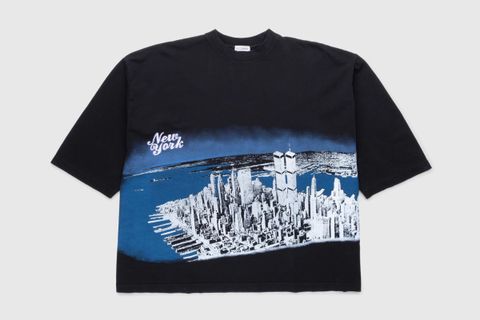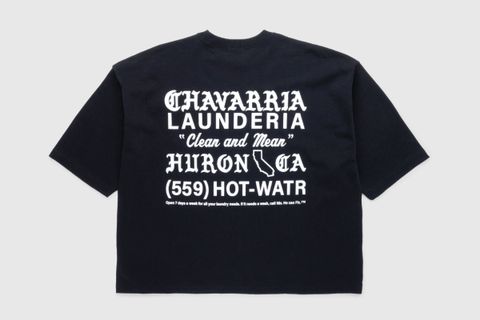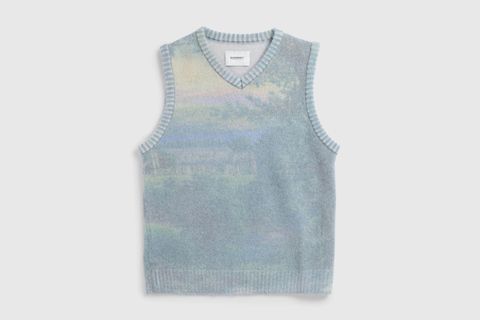Willy Chavarria Deserves the Love — His Clothes Do, Too
I remember first stumbling across Willy Chavarria's humble Sullivan Street store back in 2017. The unassuming storefront, painted white with plastic chairs to match, betrayed nothing about the riotously forward-looking menswear that laid inside.
Back then, Chavarria was still a pretty local designer, someone you'd only know if you'd pulled at the threads of Palmer Trading Co., the workwear-y label he co-founded in 2010 that was stocked at Opening Ceremony, or saw his work at indie boutiques like the now-defunct SWORD-SMITH in Brooklyn.
But once you drank in Chavarria's all-gender, all-massive clothing, you didn't forget it. At once familiar and alien, it looked like nothing else — the Willy Chavarria brand debuted in 2015, the same year that Demna joined Balenciaga — and proved so ahead of its time that it took nearly a decade for the rest of fashion to catch up.
Finally, catch up it did. It was only a year or two after the COVID-19 pandemic that Chavarria began collecting critical acclaim like so many lucky pennies. Every New York Fashion Week brought another handful of breathy profiles, describing Chavarria as a "renegade" (he is) and proclaiming that he's about to become fashion's next household name (wishful but worthy thinking).
They mention Chavarria's work ethic (exhaustive). They mention his creative family (expansive and yet intimate). They mention his background and the representation reflected in his runway shows and even in Chavarria himself, as a queer Latino designer working in an business that's still primarily white.
All valid points. All entirely deserved.
But they do not mention his clothes, not often enough. To be fair, that's not their fault.
“The clothes, as amazing as they are, often feel secondary to the people and places we highlight,” Marcus Correa, Chavarria's preferred stylist, once told us.
And it's true: part of the Willy Chavarria magic is that it isn't just Willy Chavarria. It's the people of Willy Chavarria.
It's people of color underrepresented by an industry only too happy to appropriate their culture and exploit their image. It's people of unconventional beauty who don't fit into narrow American standards and yet who walk Chavarria's runways regardless. It's people who exist outside of and even reject the actual ugliness lurking beneath fashion's polished veneer, people as exhausted as Chavarria with fashion's artificial barricades, high cost of entry, arbitrary rules and arbitrary games.
Authentic iconoclasm is a key part of the Willy Chavarria story and it's at least partially what makes his brand so essential. It's not just clothes.
And, yet, most discussions of Chavarria really do not do his clothes justice.
Because, as important as it is that Chavarria exists as a beacon of representation, of what fashion ought to be, it's also important that he makes good clothes. Because he makes really, really good clothes.
Back in 2015, no one was doing bigger jeans or wider shirts and Chavarria has only refined his design ethos since.
Though his signature garments, like the drop-shoulder Buffalo T-shirts and generous Big Willy shirts, are still in place, they're accompanied by a vast assortment of theatrical statement pieces and approachable layering pieces.
Denim trucker jackets cut so huge that two or three hoodies could be stacked beneath, wide jeans full enough to fit a person inside each leg, sportswear blown up and out to replicate the XXL Polo jackets worn by the Chicano men idolized by a young Chavarria: this may all sound familiar nowadays but it was positively prescient from the jump.
And, to be clear, it still looks darn good now.
No one is more aware that Chavarria was ahead of the curve than Chavarria himself. Recently, when asked why his newer collections (slightly) slim down that quintessentially Willy volume, Chavarria wearily answered: "[Because] everybody is now doing my oversize trousers."
He's right. But, even still, no one does it like him.
Chavarria cuts his pants — which he sells through a web store at prices far more reasonable than that of the fashion houses that imitate him — with a generous upper block and ultra-high rise. Nothing riles me more than a wide-looking pant with a middling rise — I need room and Willy Chavarria provides.
His pants are wearable, weird, and fun, as oversized trousers should be.
It's times like this I wish that New York's obscene rent prices hasn't forced Chavarria to shutter his little Soho flagship store, so that everyone could experience his clothes firsthand. I could easily write about his clothes all day but nothing's a stand-in for actual experience.
Part of Willy Chavarria's genius is his design acumen, skill that comes from literal decades in the biz (Chavarria's resume includes Calvin Klein and Ralph Lauren).
His fashion is flashy but remains grounded in a way that belies the buzz he's earned — and I mean earned, through years of thankless labor that's only just now paying off.
Little wonder Chavarria was brought in to consult on the early days of YEEZY GAP, itself a mix of fanciful reference and functional design.
You can still see some of that YEEZY-adjacency in Chavarria's washed-out jersey bombers and boxy Pope-printed T-shirts but, also, that's just Willy doing Willy: remember that YEEZY launched the same year as Chavarria's brand.
Chavarria's design acumen is so proven that he's quietly evolved into one of the rarefied designers tapped to design a Japan-only clothing line at the bequest of tastemaking Tokyo boutique WISM, which effectively places him in league with Margaret Howell and Steven Alan (except Chavarria's collection is no mere licensing gig).
The reason I'm harping on all of this is because it's part of what makes Willy Chavarria so truly, powerfully vital.
The value of what he, as a person and force, brings to a diversity-lacking industry has been discussed at length. As has the balance between Willy Chavarria, charismatic local hero, and Willy Chavarria, international name desired by A-listers like Bad Bunny, J Balvin, Billie Eilish, and Kendrick Lamar.
But it must be restated how raw, real, and true Chavarria's clothing is, how good his eye is, how how work proved potent enough to last ten years and how it'll last ten, twenty, thirty more.
Because it's about time he got his fashion flowers. For everything.


